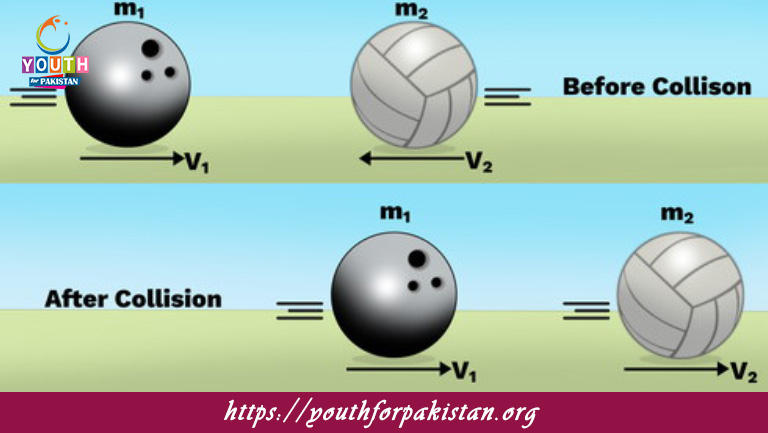Elastic Collision MDCAT MCQs with Answers

Welcome to the Elastic Collision MDCAT MCQs with Answers. In this post, we have shared Elastic Collision Multiple Choice Questions and Answers for PMC MDCAT 2024. Each question in MDCAT Physics offers a chance to enhance your knowledge regarding Elastic Collision MCQs in this MDCAT Online Test.
Elastic Collision MDCAT MCQs Test Preparations
In a perfectly elastic collision, which of the following is conserved?
a) Kinetic energy
b) Momentum
c) Both kinetic energy and momentum
d) Neither kinetic energy nor momentum
During an elastic collision, the relative velocity of approach is equal to:
a) The relative velocity of separation
b) The sum of the velocities
c) The difference of the velocities
d) Zero
In a one-dimensional elastic collision between two objects, if the initial velocity of object A is
v
A
and object B is stationary, the final velocity of object A after the collision is given by:
a)
v
A
b)
v
B
c)
−
+
m
A
+m
B
m
A
−m
B
v
A
d)
2
+
m
A
+m
B
2m
B
v
A
For a perfectly elastic collision, the total kinetic energy of the system:
a) Decreases
b) Increases
c) Remains constant
d) Becomes zero
If two identical objects collide elastically and rebound with the same speed, their final velocities are:
a) The same as their initial velocities
b) Zero
c) Doubled
d) Half of their initial velocities
In a perfectly elastic collision between two balls of equal mass, if one ball is initially stationary, the velocities of the balls after the collision are:
a) Swapped
b) Remain unchanged
c) Zero
d) Double their initial values
The coefficient of restitution for a perfectly elastic collision is:
a) Zero
b) One
c) Greater than one
d) Less than one
In a two-dimensional elastic collision, which of the following quantities is conserved?
a) Only the x-component of momentum
b) Only the y-component of momentum
c) Both the x and y components of momentum
d) Kinetic energy only
For an elastic collision on a frictionless surface, the total momentum before and after the collision:
a) Is not conserved
b) Increases
c) Remains constant
d) Decreases
If a moving ball collides elastically with a stationary ball of the same mass, the moving ball:
a) Stops and the stationary ball moves with the initial velocity of the moving ball
b) Continues with the same velocity
c) Rebounds with the same velocity
d) Moves in the opposite direction with double velocity
In an elastic collision between two objects, if the first object is much more massive than the second, the second object:
a) Experiences a larger change in velocity
b) Experiences no change in velocity
c) Rebounds with a smaller velocity
d) Has the same velocity after the collision
The conservation of kinetic energy in elastic collisions leads to:
a) An increase in total energy
b) A decrease in total energy
c) No change in total kinetic energy
d) An increase in potential energy
In an elastic collision where two objects have the same mass and collide head-on, their final velocities:
a) Are equal to their initial velocities but in opposite directions
b) Are the same as before the collision
c) Are zero
d) Are halved
In an elastic collision, the total momentum of a two-body system:
a) Changes depending on the mass
b) Remains constant
c) Depends on the type of collision
d) Becomes zero
During an elastic collision between two objects, the center of mass velocity:
a) Changes
b) Remains constant
c) Becomes zero
d) Depends on the masses of the objects
For two objects colliding elastically in space, the total energy of the system:
a) Decreases
b) Remains constant
c) Increases
d) Becomes zero
If the relative velocity of approach in an elastic collision is 10 m/s, the relative velocity of separation will be:
a) Less than 10 m/s
b) Greater than 10 m/s
c) Equal to 10 m/s
d) Zero
In an elastic collision on a frictionless surface, the relative speed of two colliding objects:
a) Increases
b) Decreases
c) Remains unchanged
d) Becomes zero
The coefficient of restitution for a collision is defined as:
a) The ratio of final to initial kinetic energy
b) The ratio of final to initial momentum
c) The ratio of relative velocities after and before the collision
d) The total energy before the collision
For an elastic collision between two objects of equal mass, if one object is initially at rest, the final velocities are:
a) Swapped
b) The same as the initial velocities
c) Zero
d) Doubled
When two objects collide elastically in two dimensions, the angle between their velocities after collision depends on:
a) The masses of the objects
b) The relative velocities before the collision
c) The type of collision
d) The initial kinetic energy
In a perfectly elastic collision, the change in momentum for each object is:
a) Equal and opposite
b) Zero
c) Dependent on mass
d) Twice the initial momentum
In a perfectly elastic collision, the velocity of the center of mass:
a) Changes
b) Remains constant
c) Becomes zero
d) Depends on the individual velocities
When two objects collide elastically and one object is initially stationary, the final velocities can be found using:
a) Conservation of momentum and conservation of energy
b) Conservation of momentum only
c) Conservation of energy only
d) The law of universal gravitation
If the total kinetic energy before an elastic collision is 100 J, the total kinetic energy after the collision will be:
a) Less than 100 J
b) Greater than 100 J
c) 100 J
d) Zero
For a perfectly elastic collision, the momentum and kinetic energy are:
a) Both conserved
b) Both not conserved
c) Momentum is conserved, but not kinetic energy
d) Kinetic energy is conserved, but not momentum
In an elastic collision, the direction of motion of two colliding objects:
a) Always reverses
b) Always stays the same
c) May change depending on the collision angle
d) Becomes random
For two objects colliding elastically, the relative speed of separation is always:
a) Equal to the relative speed of approach
b) Less than the relative speed of approach
c) Greater than the relative speed of approach
d) Zero
In a perfectly elastic collision between two unequal masses, the more massive object:
a) Experiences a greater change in velocity
b) Experiences a smaller change in velocity
c) Experiences no change in velocity
d) Moves with the same final velocity as the smaller object
The energy lost in an elastic collision:
a) Is transformed into kinetic energy
b) Is conserved as kinetic energy
c) Is transformed into potential energy
d) Is zero
If two objects collide elastically and one object is much heavier, the lighter object will:
a) Move with a larger velocity change
b) Move with no change in velocity
c) Move with a smaller velocity change
d) Move in the opposite direction with the same velocity
In an elastic collision, the work done by internal forces of the system:
a) Increases the total energy
b) Decreases the total energy
c) Does not change the total energy
d) Is equal to the change in kinetic energy
During an elastic collision, if the masses of the two objects are equal, the velocities after the collision:
a) Are swapped
b) Remain the same
c) Are halved
d) Become zero
For two objects colliding elastically on a frictionless surface, the total momentum and kinetic energy:
a) Both increase
b) Both decrease
c) Momentum is conserved; kinetic energy is conserved
d) Momentum is not conserved; kinetic energy is conserved
If a moving object collides elastically with a stationary object of the same mass, the stationary object:
a) Moves with the velocity of the moving object
b) Remains stationary
c) Moves with twice the velocity of the moving object
d) Moves in the opposite direction
The velocity of the center of mass in an elastic collision of two objects:
a) Changes
b) Remains unchanged
c) Depends on the masses
d) Becomes zero
The change in kinetic energy for a perfectly elastic collision:
a) Is zero
b) Is equal to the total energy
c) Is equal to the work done
d) Depends on the masses of the objects
The coefficient of restitution is a measure of:
a) The energy lost in the collision
b) The kinetic energy of the system
c) The degree of elasticity of the collision
d) The total momentum of the system
In an elastic collision, the direction of momentum change for each object:
a) Is opposite to the direction of velocity change
b) Is the same as the direction of velocity change
c) Is random
d) Cannot be determined
If you are interested to enhance your knowledge regarding Physics, Chemistry, Computer, and Biology please click on the link of each category, you will be redirected to dedicated website for each category.





